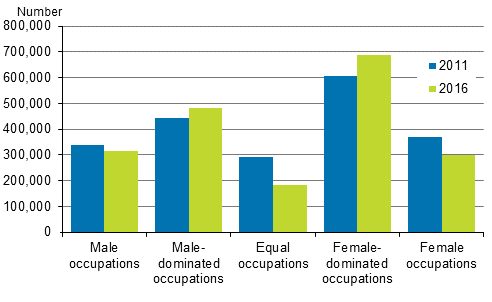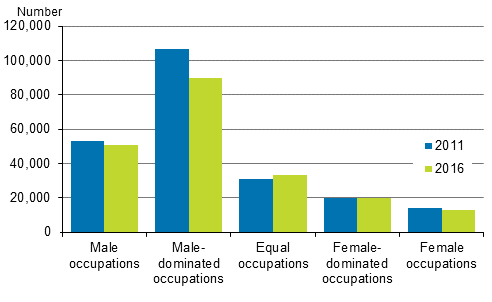2. Professional differentiation among wage and salary earners and entrepreneurs in 2016 and 2011
Professional differentiation by sex, segregation, is based on the classification of occupational groups by gender proportions. The strength of the segregation is determined based on how many wage and salary earners work in equal occupational groups.
Table 1. 5-class segregation classification of occupations
| Segregation class | The occupational groups in which |
| Female occupation | women > 90 % |
| Female-dominated occupation | 60 % < share of women <= 90 % |
| Equal occupation | 40 % <= share of women / men <= 60 % |
| Male-dominated occupation | 60 % < share of men <= 90 % |
| Male occupation | men > 90 % |
The segregation classification of wage and salary earners and entrepreneurs was examined based on the 5-digit level of the Classification of Occupations 2010.
2.1 Professional differentiation among wage and salary earners strengthened from 2011 to 2016In all, 9.3 per cent of all wage and salary earners were in 2016 in so-called equal occupational groups, where the share of different sexes among those included in the occupational group is 40 to 60 per cent. The share of wage and salary earners working in equal occupations among all wage and salary earners (excl. occupational data missing) was five percentage points lower in 2016 than in 2011.
Figure 1. Number of wage and salary earners in various segregation classes in 2011 and 2016

The following occupational groups have been removed from equal occupations of wage and salary earners during five years: commercial sales representatives (36,400), mail carriers (11,900) and policy administration professionals (15,000). In total, 112,700 persons and around 20 occupational groups were removed from equal occupations of wage and salary earners in five years. And even if around 20 equal occupational groups were created, they were clearly smaller than those removed from equal occupations.
The biggest occupational groups that have become equal occupational groups were management and organisation analysts (5,900 persons cf. commercial sales representatives 36,400), building architects (3,200) and credit and loans officers (3,000). Only 20,000 wage and salary earners were working in occupations that have become more even by their gender distribution.
For wage and salary earners, the most evenly divided occupational groups are mathematicians, actuaries and statisticians (in total 1,600 persons, 49.9 % women and 50.1 % men), handicraft workers in wood, basketry and related materials (in total around 100 persons, 50.0 % women and 50.0 % men) and financial and investment advisers (in total 3,300 persons, 50.1 % women and 49.9 % men).
In 2016, wage and salary earners' most common equal occupational groups were food and related products machine operators (14,700), advertising and marketing professionals (14,200) and vocational education teachers (14,000).
Table 2. Wage and salary earners aged 18 to 74 in segregation classes in 2016 1)
| Segregation class | Wage and salary earners | Share of wage and salary earners, % | Women | Share of women, % | Men | Share of men, % |
| Female occupations | 299,039 | 15.2 | 280,696 | 27.4 | 18,343 | 1.9 |
| Female-dominated occupations | 686,524 | 34.9 | 520,465 | 50.8 | 166,059 | 17.6 |
| Equal occupations | 182,931 | 9.3 | 93,776 | 9.1 | 89,155 | 9.5 |
| Male-dominated occupations | 482,559 | 24.5 | 114,419 | 11.2 | 368,140 | 39.1 |
| Male occupations | 315,161 | 16.0 | 15,637 | 1.5 | 299,524 | 31.8 |
| Total | 1,966,214 | 100.0 | 1,024,993 | 100.0 | 941,221 | 100.0 |
2.2 More entrepreneurs worked in equal occupations in 2016 than in 2011
In all, 16.4 per cent of all entrepreneurs were in 2016 in equal occupations, where the share of different sexes among those included in the occupational groups is 40 to 60 per cent. The share of entrepreneurs working in equal occupations among all entrepreneurs (excl. occupational data missing) was around three percentage points higher in 2016 than in 2011. The examination disregards the fact that women's share of all entrepreneurs is only 33 per cent.
Figure 2. Number of entrepreneurs in various segregation classes in 2011 and 2016

For entrepreneurs, occupational groups that have become equal occupations in five years were such as massage therapists and practical rehabilitation nurses (2,800), gardeners, horticultural and nursery growers (1,200) and stall and market salespersons (500). The biggest one of the removed equal occupational groups was upholsterers and related workers (400). In five years, 6,000 persons entered equal occupations of entrepreneurs and around 1,400 were removed from there.
For entrepreneurs, the most evenly divided occupational groups are graphic and multimedia designers (in total 700 persons, 50.4% women and 49.6% men), general medical practitioners (in total around 500 persons, 49.9% women and men 50.1%), and domestic housekeepers (in total 500 persons, 49.3% women and 50.7% men).
In 2016, the most common equal occupational groups of entrepreneurs were shop keepers (10,300), restaurant services supervisors and shift managers (4,100) and massage therapists and practical rehabilitation nurses (2,800).
Table 3. Entrepreneurs aged 18 to 74 in segregation classes in 2016 1)
| Segregation class | Entrepreneurs | Share of entrepreneurs, % | Women | Share of women, % | Men | Share of men, % |
| Female occupations | 13,420 | 6.2 | 12,663 | 18.2 | 757 | 0.5 |
| Female-dominated occupations | 17,491 | 8.1 | 12,511 | 17.9 | 4,980 | 3.4 |
| Equal occupations | 35,340 | 16.4 | 17,064 | 24.5 | 18,276 | 12.5 |
| Male-dominated occupations | 95,796 | 44.3 | 24,433 | 35.0 | 71,363 | 48.8 |
| Male occupations | 53,974 | 25.0 | 3,090 | 4.4 | 50,884 | 34.8 |
| Total | 216,021 | 100.0 | 69,761 | 100.0 | 146,260 | 100.0 |
Source: Employment Statistics, Statistics Finland
Inquiries: Juho Keva 029 551 3601, Elina Mikkelš 029 551 2973, info@stat.fi
Director in charge: Jari Tarkoma
Updated 2.11.2018
Official Statistics of Finland (OSF):
Employment [e-publication].
ISSN=2323-6825. Industry, employer sector and jobs 2016,
2. Professional differentiation among wage and salary earners and entrepreneurs in 2016 and 2011
. Helsinki: Statistics Finland [referred: 17.8.2024].
Access method: http://www.stat.fi/til/tyokay/2016/04/tyokay_2016_04_2018-11-02_kat_002_en.html

